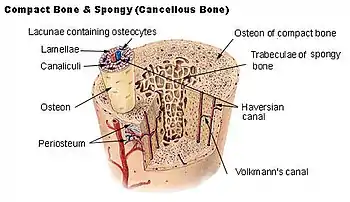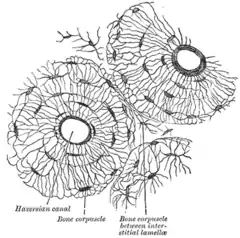Havers-Kanal
Ein Havers-Kanal (Syn. Haversscher Kanal) ist der zentrale Kanal in der Mitte eines Osteons, der funktionellen Grundeinheit in der Knochenrinde (Substantia compacta). Er wird von 5 bis 20 µm dicken Knochenlamellen konzentrisch umschlossen. Im Inneren befinden sich kleine Blutgefäße mit fenestriertem Endothel (Sinusoide) sowie häufig nicht-myelinisierte Nervenfasern. Somit dient ein Havers-Kanal zur Nährstoffversorgung und Reizübertragung. Über so genannte Kanälchen (Canaliculi) stehen die Knochenzellen (Osteozyten) mit dem Havers-Kanal in Verbindung. Benachbarte Havers-Kanäle sind über Volkmann-Kanäle miteinander verbunden.

Aufbau eines Knochens

Havers-Kanäle im Knochen
Der britische Arzt Clopton Havers (1657–1702) entdeckte die nach ihm benannten Kanäle im Jahr 1691.
Literatur
- Clopton Havers: Osteologia nova, sive novae quedam observationes de ossibus et partibus ad illa pertinentibus... Francofurti & Lipsiae, Apud Georgium Wilhelmum Kuhnium, 1692.
- Clopton Havers: A Short Discourse Concerning Concoction: Read at a Meeting of the Royal Society. In: Philosophical Transactions. 21/1699, S. 233–47.
- S. Mohsin: Three dimensional reconstruction of haversian canals using X-ray micro-computed tomography. In: Bone. 38/2006, S. 16.
- I. Albu et al.: Haversian canals anastomoses in the long human bones. In: Morphologie et embryologie. 33/1987, S. 167–9.
- C. Veleanu et al.: A simple and effective technique for haversian canals injection. In: Folia Morphologica. 21/1973, S. 27–30.
- H.-J. Wagner: Grundzüge der molekularen Histologie – Knorpel- und Knochengewebe. Anatomisches Institut der Universität Tübingen
This article is issued from Wikipedia. The text is licensed under Creative Commons - Attribution - Sharealike. The authors of the article are listed here. Additional terms may apply for the media files, click on images to show image meta data.